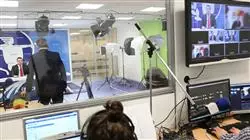University certificate
The world's largest faculty of journalism and communication”
Introduction to the Program
This program in Television Journalism will allow you to develop all your knowledge of the creation and broadcasting of stories in a professional way"

Journalism studies are one of the most demanded in all universities, since this profession has a great influence on the population and has gained great prominence since its beginnings. Journalism encompasses different branches: social, cultural, economic, sports, international, events, conflicts, etc. This makes it necessary for professionals in this sector to specialize in order to tell stories in the most appropriate way in each case.
Additionally, the transmission of information can be carried out through different media. Specifically, this program aims to specialize students in Television Journalism. To do so, it is necessary to acquire a series of skills that allow you to put into practice all that has been learned.
The syllabus addresses the audiovisual narrative, essential for the development of any information in this medium. And, as it could not be otherwise, focuses on communication and Television Journalism, in order to delve students into all the particularities of this field.
This program is the most complete and directed so that the professionals in the field of Journalism and communication reach a superior level of performance, based on the fundamentals and the latest trends in Television Journalism.
Work with the best teaching professionals in this Postgraduate diploma with curricular value of excellence”
This Postgraduate diploma in Television Journalism contains the most complete and up-to-date program on the market. The most important features include:
- The development of case studies presented by experts in television journalism
- The graphic, schematic, and practical contents with which they are created provide scientific and practical information on the disciplines that are essential for professional practice
- News on Television Journalism
- Practical exercises where the self-assessment process can be carried out to improve learning
- Its special emphasis on innovative methodologies in television journalism
- The interactive learning system based on algorithms for decision-making on the situations posed in Television Journalism
- Theoretical lessons, questions to the expert, debate forums on controversial topics, and individual reflection assignments
- Content that is accessible from any fixed or portable device with an Internet connection
This Postgraduate diploma is perfect for you to learn how to tell the story you want to tell and do it in a professional way”
Its teaching staff includes professionals from the world of journalism, who bring to this program the experience of their work, as well as renowned specialists from prestigious reference societies and universities.
Its multimedia content, developed with the latest educational technology, will enable the professional to contextual and situated learning, i.e., a simulated environment that will provide immersive learning programmed to prepare in real situations.
This program is designed around Problem-Based Learning, whereby the professional must try to solve the different professional practice situations that arise throughout the program. To do so, the professionals will be assisted by an innovative interactive video system developed by renowned and experienced experts in the field of Television Journalism.
Don't miss the opportunity to increase your competence in Television Journalism"

Know the latest trends in Television Journalism and be the best in this sector"
Why study at TECH?
TECH is the world’s largest online university. With an impressive catalog of more than 14,000 university programs available in 11 languages, it is positioned as a leader in employability, with a 99% job placement rate. In addition, it relies on an enormous faculty of more than 6,000 professors of the highest international renown.

Study at the world's largest online university and guarantee your professional success. The future starts at TECH”
The world’s best online university according to FORBES
The prestigious Forbes magazine, specialized in business and finance, has highlighted TECH as “the world's best online university” This is what they have recently stated in an article in their digital edition in which they echo the success story of this institution, “thanks to the academic offer it provides, the selection of its teaching staff, and an innovative learning method aimed at educating the professionals of the future”
A revolutionary study method, a cutting-edge faculty and a practical focus: the key to TECH's success.
The most complete study plans on the university scene
TECH offers the most complete study plans on the university scene, with syllabuses that cover fundamental concepts and, at the same time, the main scientific advances in their specific scientific areas. In addition, these programs are continuously being updated to guarantee students the academic vanguard and the most in-demand professional skills. In this way, the university's qualifications provide its graduates with a significant advantage to propel their careers to success.
TECH offers the most comprehensive and intensive study plans on the current university scene.
A world-class teaching staff
TECH's teaching staff is made up of more than 6,000 professors with the highest international recognition. Professors, researchers and top executives of multinational companies, including Isaiah Covington, performance coach of the Boston Celtics; Magda Romanska, principal investigator at Harvard MetaLAB; Ignacio Wistumba, chairman of the department of translational molecular pathology at MD Anderson Cancer Center; and D.W. Pine, creative director of TIME magazine, among others.
Internationally renowned experts, specialized in different branches of Health, Technology, Communication and Business, form part of the TECH faculty.
A unique learning method
TECH is the first university to use Relearning in all its programs. It is the best online learning methodology, accredited with international teaching quality certifications, provided by prestigious educational agencies. In addition, this disruptive educational model is complemented with the “Case Method”, thereby setting up a unique online teaching strategy. Innovative teaching resources are also implemented, including detailed videos, infographics and interactive summaries.
TECH combines Relearning and the Case Method in all its university programs to guarantee excellent theoretical and practical learning, studying whenever and wherever you want.
The world's largest online university
TECH is the world’s largest online university. We are the largest educational institution, with the best and widest online educational catalog, one hundred percent online and covering the vast majority of areas of knowledge. We offer a large selection of our own degrees and accredited online undergraduate and postgraduate degrees. In total, more than 14,000 university degrees, in eleven different languages, make us the largest educational largest in the world.
TECH has the world's most extensive catalog of academic and official programs, available in more than 11 languages.
Google Premier Partner
The American technology giant has awarded TECH the Google Google Premier Partner badge. This award, which is only available to 3% of the world's companies, highlights the efficient, flexible and tailored experience that this university provides to students. The recognition as a Google Premier Partner not only accredits the maximum rigor, performance and investment in TECH's digital infrastructures, but also places this university as one of the world's leading technology companies.
Google has positioned TECH in the top 3% of the world's most important technology companies by awarding it its Google Premier Partner badge.
The official online university of the NBA
TECH is the official online university of the NBA. Thanks to our agreement with the biggest league in basketball, we offer our students exclusive university programs, as well as a wide variety of educational resources focused on the business of the league and other areas of the sports industry. Each program is made up of a uniquely designed syllabus and features exceptional guest hosts: professionals with a distinguished sports background who will offer their expertise on the most relevant topics.
TECH has been selected by the NBA, the world's top basketball league, as its official online university.
The top-rated university by its students
Students have positioned TECH as the world's top-rated university on the main review websites, with a highest rating of 4.9 out of 5, obtained from more than 1,000 reviews. These results consolidate TECH as the benchmark university institution at an international level, reflecting the excellence and positive impact of its educational model.” reflecting the excellence and positive impact of its educational model.”
TECH is the world’s top-rated university by its students.
Leaders in employability
TECH has managed to become the leading university in employability. 99% of its students obtain jobs in the academic field they have studied, within one year of completing any of the university's programs. A similar number achieve immediate career enhancement. All this thanks to a study methodology that bases its effectiveness on the acquisition of practical skills, which are absolutely necessary for professional development.
99% of TECH graduates find a job within a year of completing their studies.
Postgraduate Diploma in Television Journalism.
Television journalism is the production and transmission of news through television. It is a format of journalism that is used to report on current events, notable happenings, relevant events and any other type of information that is considered important to society.
Television journalism focuses on visual and audio presentation of news, which gives it a different approach than print journalism or online journalism. In this format, journalists use live video footage or prerecorded recordings, archival footage, interviews and other visual and audio resources to tell stories and report news.
This type of journalism is also characterized by immediacy, as television can transmit news instantly, in real time, allowing people to be aware of what is happening in the world at that moment. In addition to being an important source of information, television journalism also seeks to entertain and captivate its audience, so it often uses attractive and emotional production and presentation techniques to keep the viewer's interest. However, it should be noted that television presentation should not lead to misinformation or lack of journalistic rigor in the news content.
TECH the world's largest digital university has an academic program designed to provide students with the skills and knowledge necessary to produce and broadcast television news professionally, ethically and efficiently. Students learn to make a critical evaluation of television messages, knowing the editing and production techniques used in the medium and the tools by which the quality of information can be determined. This program is aimed at journalists and other communication professionals who wish to specialize or broaden their knowledge in the field of television journalism.







